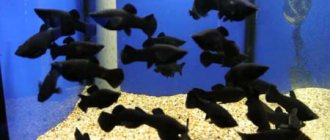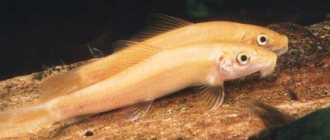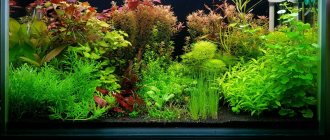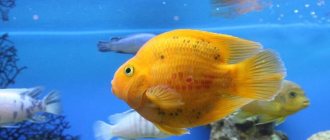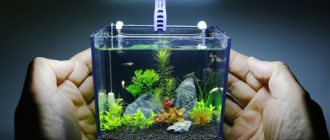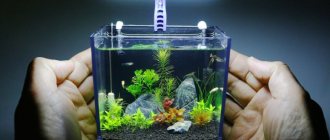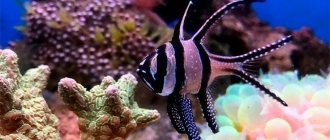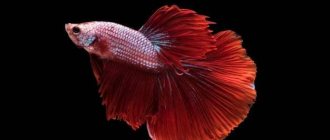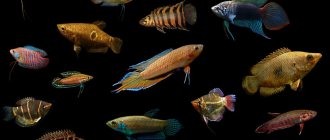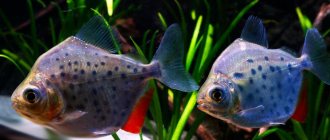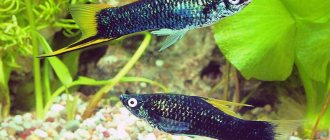The Siamese algae eater or crossocheilus siamensis lives mainly in Asian countries: Thailand, Sumatra, Indonesia. An abbreviation for Siamese Algae Eater is also often found - SAE, not to be confused with SAE, the Chinese algae eater (gerinocheilus). Natural habitat is streams and small rivers with fast currents and rocky or sandy bottoms. Algae growing on snags and submerged tree roots are the basis of the fish’s diet.
It appeared in Russia in 1962, and since 1970 it has been valued by aquarists for its food preferences. Introducing an algae eater into the aquarium eliminates frequent interventions in the ecosystem. The algae-eating fish is a natural cleaner. There is no need to add agents to the water to prevent the proliferation of unwanted vegetation.
Description
The Siamese algae eater belongs to the carp family. The body is oblong gray-brown. The belly is lighter than the back. There is a black jagged stripe along the side.
This breed requires a spacious aquarium of 50 liters per fish.
The algae eater is the only fish that successfully fights blackbeard (parasitic algae).
In nature, adult individuals reach a height of 15 cm, in aquariums they are often 8–10 cm.
Siamese algae eater and false siamese algae eater
A true crosstail coexists with a false Siamese in the same body of water. Juveniles of both species form joint schools. Often pet stores sell both together. SAE is confused with the flying fox. The breed is distinguished by its mustache, fins, color and behavior.
Comparison table between real and false algae eaters based on external characteristics:
| Parameter | Siamese algae eater | flying fox |
| Black stripe on the side | captures the rear fin, zigzag | does not go into the fin, flat |
| Strip around the mouth | clear | blurry |
| Fins | transparent | yellow |
| Mustache | 2 | 4 |
| Degree of aggressiveness | low | high |
| Rest | does not use pectoral fins | rest on the tail, lower and pectoral fins |
| Scales on the back | each with a black border creates a mesh pattern | evenly colored |
The antennae are difficult to see when moving. In a stressful situation, algae-eating fish lighten up and a stripe is clearly visible, which in the original fish goes onto the fin, but in the false Siamese it ends before the start.
The main difference between the Siamese algae eater is its feeding habits.
Neither the Siamese flying fox, nor Crossocheilus langei, nor Crossocheilus atrilimes, sold as SAE, eat algae to the same extent, but they will destroy aquarium mosses.
Shrimps
Amano
These are Japanese pond shrimp, the main delicacy of which is filamentous algae. The larger the Amano shrimp, the coarser the algae they destroy. Having reached an adult state, they are able to destroy all algae, including cladophora. They will not help get rid of green plaque and xenococcus.
You should not expect high efficiency from them. Amano are significantly inferior to neocardins, and to destroy black beard it is better to use the Siamese algae eater. To maintain cleanliness in the herbalist, it is enough to keep no more than 5 pieces per 200-liter aquarium.
Neocaridina
This is the most common type of shrimp to keep in a herbalist. They are easy to grow and effective at killing soft filamentous algae such as Rhizoclonium. They are usually used when starting an aquarium to destroy green plaque and plant debris.
Content
Temperament – peaceful, accommodating. Carp, which are very active by nature, often jump out of the aquarium. To avoid killing your fish, use a lid or plants to cover the surface of the water.
Water parameters
| acidity | 6.5–8 pH |
| rigidity | 5–20 dGH |
| water temperature | 24–26 degrees |
The aquarium fish Siamese algae eater prefers cleanliness and freshness. Once a week, 1/3 of the water volume is changed.
Aquarium
The size of the aquarium for keeping Gyrinocheilus siamese is from 100 liters. The shape is elongated. The decor is moderate so that the fish can move freely.
Priming
Siamese algae eaters in an aquarium collect settled algae from the bottom. Use dense sand or pebbles as soil. Similar substrates are sold in pet stores. The soil needs to be siphoned about once a month to remove food debris.
If you collected the stones yourself, bake them on a baking sheet or boil them before placing them in the aquarium to avoid pests.
Lighting
Natural sparse or artificial lighting is suitable for the Siamese algae eater.
Shield the aquarium from direct sunlight with curtains and indoor plants. For artificial lighting, choose fluorescent lamps with a power of 0.5 W/l.
Fish need 12 hours of daylight.
Equipment
In nature, algae eaters live in bodies of water with fast currents. The water in them is clean and oxygenated. In an aquarium, filtration and increased aeration are constantly necessary. Choose powerful devices, otherwise the fish will feel uncomfortable and may get sick.
Plants
Plants with dense, large leaves are suitable for planting in an aquarium. The fish will rest on them. When disembarking, leave enough space to move around.
Riccia and duckweed on the surface will prevent the SAE algae eater from jumping out of the aquarium.
Mosses are the only plant not suitable for growing with this breed. Any plant species that resemble algal growths will be destroyed.
With enough food, carps do not damage plants.
Spreading
Crossocheilus siamensis is native to Southeast Asia.
Here in Indochina, they live in small rivers and streams of the Mekong River basin. In its natural environment, the algae eater can be found in Indonesia, Suriname, Thailand, and the Malay Archipelago.
Reservoirs usually have a current, their bottom is sandy, and at the bottom there are many snags and boulders, which are used as shelters.
The sun's rays penetrate well through fairly clear water, which causes active growth of algae, which ensures the food preferences of fish.
Compatibility
The algae-eating catfish is peaceful and gets along with active fish and most aquarium inhabitants.
Incompatible:
- Labeo two-color. The fight for territory between these related breeds leads to the death of fish.
- Veils. Algae eaters bite their fins.
- Cichlids. SAE activity bothers them during spawning.
Schooling fish. They require the company of 3–8 individuals of their own species.
View this post on Instagram
Rasbora Sawbwa Resplendens e Comedor de Alga Siamês Verdadeiro! Lindos para o seu aqua plantado. Disponíveis em www.ecoanimal.com.br #rasbora #sawbwa #Aquanimal #crossocheilus
A post shared by Aquanimal (@aquanimal_insta) on Jun 19, 2022 at 5:42pm PDT
Two males, when kept together, injure each other. If you want several fish, get one boy and a bunch of girls.
Feeding
In nature, food consists mostly of algae and less of live food. With age, the proportions change and adults consume more protein than plant foods. There is less vegetation in the aquarium. Feed your pet live, artificial and frozen food.
Feed your fish once a day.
Nutrition should be balanced and varied. The main food remains algae. Add vegetables to your diet after scalding them with boiling water.
Fish eat:
- cucumbers;
- zucchini;
- salad;
- spinach.
Pet stores sell ready-made mixtures for carp.
Animal food is necessary to support the growth of algae eaters. Suitable food:
- cyclops;
- Daphnia;
- bloodworm;
- tubifex
When catching food yourself, there is a possibility of introducing bacteria. An alternative is frozen food. It undergoes heat treatment to remove all harmful components. Before giving frozen food to the fish, remove it from the refrigerator and leave it for 15 minutes. Store at -18 degrees. Give as much food as your pets will eat in 3 minutes, otherwise the risk of water contamination will increase.
Overfed Siamese algae eaters are indifferent to algae and therefore do not clean the aquarium. Keep SAE in a semi-starved state. Juveniles in the role of orderlies are the most active.
Neighborhood
Siamese algae eaters do not have aggressive intentions towards any other species, however, within the flock “showdowns” between males are not excluded. The fish are very lively and active, they actively move around the aquarium, which can frighten or cause stress to too timid neighbors.
That is why among the neighbors of Siamese algae eaters there should not be some tetras, as well as cichlids, which protect their territory before breeding.
It is not recommended to keep individuals with veiled tails together with Crossocheilus siamensis - out of curiosity and due to natural activity, these nimble cyprinids tend to ruffle and bite such decorations.
Another unwanted neighbor is the Labeo. They belong to the same family as algae eaters, as a result of which interspecific fights between males are possible.
Reproduction
Does not reproduce in aquarium conditions. Caviar is extremely vulnerable to fungi and infections. The fry die at the maturation stage.
They often sell wild-caught fish. Despite the impossibility of breeding, the fish is often found on the shelves of pet stores.
Sex differences
Weak sexual dimorphism. The female is larger and more rounded than the male.
When purchasing, consult a specialist; it is difficult to notice the difference with the naked eye.
Aquarium algae-eating fish - TOP 8
Post Views: 2,206
5
(3)
Caring for a home aquarium is a painstaking task. An aquarist regularly has to perform many manipulations - from changing water to cleaning glass, soil and decorations from growing algae. And all this is necessary to create comfortable conditions for the fish and achieve the desired aesthetics. The fight against algae would be even more difficult if there were no living helpers - the so-called cleaners. These include aquarium inhabitants who clean algal growth from walls, decorations, and plants. As a result of their vital activity, they help maintain cleanliness in the aquarium. We offer you an article on the topic “Aquarium fish that eat algae.” We hope this helps you choose the perfect mate for your aquarium!
Ancistrus sp.
A popular species of catfish in hobbyist aquariums. The entire body of ancistrus is covered with rows of polygonal shaped bone plates. Under natural conditions, such a shell serves them as reliable protection from enemies. In an aquarium, with the right selection of neighbors, he, of course, will not need it, and the catfish itself has a peaceful character. The mouth of ancistrus resembles a suction cup in shape. Thanks to this shape, it easily stays on stones and snags in fast current conditions, which is typical for its habitat. There are many horn-like scrapers located on the “suction cup”. It is with their help that catfish scrape off algal fouling from the decorations and walls of the aquarium. This process can be very interesting and funny to watch. Ancistrus are most active in the dark, but in aquarium conditions they easily adapt, get used to the feeding regime and are often active even during the day. These catfish help quite well in cleaning the aquarium while they are young; with age, their zeal fades somewhat.
There are a large number of species of ancistrus, differing in size and color. The family contains both small species, several centimeters long, and giants: some pterygoplichths can reach up to 35-40 cm in length. In an aquarium, ancistrus grow on average to 10-15 cm. As for color, it can be brownish, all shades of gray - from light gray to dark gray, black with light spots. There are varieties colored brick red or orange, or albino catfish with a golden beige color.
The appearance of male ancistrus is especially impressive due to the skin processes called tentacles. They grow all over their heads, and in large adult individuals the length of these processes can reach 1.5-2 cm. But in females the mustache is either very poorly developed or completely absent.
The peacefulness and calmness of these catfish made them ideal neighbors for almost all types of aquarium fish. They get along well with small and medium-sized schooling fish. The most interesting thing is that even aggressive species of medium-sized fish rarely touch ancistrus, apparently due to their shell. With proper care and comfortable conditions, these catfish live in an aquarium for 5-6 years.
Labeo
Labeo is a genus of fish in the carp family. Their habitat is Asia and Africa. The diet of these benthic freshwater fish is based on algae fouling. Labeo are real aquarium orderlies, thanks to whom it is possible to fight lower plants in a natural biological way. The beautiful fish has a small head, large eyes, a thick-lipped mouth with 2 pairs of short antennae, a two-lobed tail, and a high dorsal fin, which in appearance looks a little like a shark. An adult in an aquarium can reach a maximum of 10-15 cm.
The peculiarities of most fish of this genus include the contrasting color of the fins and body, as well as a somewhat unusual method of swimming: they can stay in the water in an upright position or even swim with their belly up. The color depends on the specific species.
In addition to beauty and “hard work”, the Labeo has one drawback - its quarrelsome character. Finding neighbors for a beautiful fish will not be easy. Due attention should be paid to zoning in order to minimize clashes between the inhabitants of the aquarium. If this condition is met, labeos can get along with barbs, angelfish, zebrafish, gouramis, and platies.
Features of the content also include “love of space.” Representatives of the genus will feel comfortable in an aquarium of at least 200 liters.
Farlowella acus
Farlovela is a species of ray-finned fish from the family Loricariidae (chainmail or loricariid catfish) has a very unusual appearance. The fish looks like the root or stem of an aquatic plant.
Farlovella has a narrow, elongated body up to 18 cm long, an elongated head and a long muzzle. The color can vary from olive green to yellow-brown. There is a dark wide stripe along the body. Due to this special camouflage, the farlovella perfectly hides from “predators” in its natural habitat. Catfish are called “strong enemies of lower plants”, “aquarium orderlies”, because they feed on algae.
You can distinguish a male from a female due to its wider head. During the mating season, “bristles” appear on it.
The advantages of the fish include unpretentiousness. In order to provide comfortable conditions, you need a spacious aquarium of at least 140 liters with a bottom made of sand or fine gravel, a large number of large-leaf plants with a powerful root system, driftwood, pieces of wood, which will serve not only as shelters, but also as a basis for the growth of algae. Because The catfish is peaceful; it also needs to choose non-aggressive neighbors.
Siamese algae eater (SAE, Siamese algae eater)
An excellent assistant in the fight against unwanted algae in an aquarium is the Siamese algae eater from the carp family. In nature, this fish can grow up to 16 cm, but in an aquarium on average they grow up to 10 cm.
This is a schooling fish, so it is better to keep it in groups of 6-8 individuals. Accordingly, the aquarium for keeping them should be from 100 liters. With age, these fish begin to literally become lazy - comfortable conditions, the absence of enemies and the feeding regime lead to the fact that they practically stop eating fouling, preferring dry food. Therefore, it is useful for them to periodically arrange “fasting days”, stimulating them to eat algae.
Externally, the fish are very attractive. They have an elongated body with a silver base color. A horizontal stripe of dark color stretches along the entire body from head to tail. It has an uneven shape, with jagged edges clearly visible on it. Above the dark stripe is a brighter light stripe, which at a certain angle becomes especially visible.
In general, the fish are peaceful and get along well with other inhabitants of the aquarium of comparable size. Neighborhood with territorial cichlids and two-colored labeos is not recommended, as they are hostile to Siamese algae eaters.
Gyrinocheilus "Chinese or Indian algae eater" (Gyrinocheilus aymonieri)
Under natural conditions, Girinocheilus grows up to 25-30 cm, so in the countries of Southeast Asia, where it comes from, this fish has commercial value. But in an aquarium, Gyrinocheilus grows to an average of 12 cm and has primarily decorative value. And most importantly, the algae eater is an assistant to aquarists, scraping and eating algae.
The fish's mouth is shaped like a suction cup. This allows him to take an almost vertical position while scraping algae from driftwood, aquarium walls and decorations. Aquarium varieties are yellow or orange in color.
Juvenile algae eaters are very calm and peaceful; they get along well with most peaceful fish in the aquarium and their relatives. But as they grow and mature, they begin to show aggression both towards their relatives and towards fish of similar size. If there are several adult specimens of Gyrinocheilus in the aquarium, then sometimes they have to be seated. The proximity to fairly large and active fish that live in the middle and upper layers will be favorable. When comfortable conditions are created, these fish live in an aquarium for up to 10 years.
Reticulated algae eater Crossocheilus, piebald epalceorhynchus or silver fox (Crossocheilus reticulatus)
The netted algae eater is a peaceful aquarium fish that helps clean the aquarium of algae. The most active “helpers” are young individuals, 5-7 cm long. As the fish grow older, they happily begin to eat dry and live food, losing interest in algae.
Crossocheilus lives in Southeast Asia, in the reservoirs of the Mekong and Chao Phraya rivers with a sandy or fine gravel bottom, which flow through the territory of Thailand, Laos, Cambodia, and Vietnam). Schooling fish actively scurry between dense thickets.
The silvery long body follows the shape of the bar. The reticulated algae eater has a pair of short whiskers on the lower lip and almost transparent fins that have no color tint. The black outline of the scales creates a mesh or dotted pattern on the body.
Distinguishing a female from a male is not so easy. The main evaluation criterion is body thickness. As a rule, females are slightly thicker than males. There are no other obvious signs of dimorphism.
Under natural conditions, the fish reach a size of 16-17 cm, but in an aquarium they do not grow more than 14 cm.
It is better to keep Crossocheilus in a spacious aquarium with a lid, because... they have good jumping ability. In general, fish are peaceful, but they like to organize harmless fights and chases, which can irritate “representatives of a calm disposition.” In order for algae eaters to feel as comfortable as possible, you need to try to reproduce natural conditions in the aquarium: plant islands with dense vegetation, create a current, organize shelters from driftwood.
Otocinclus sp.
If you have set a goal - to fight algae, otocinclus can become your faithful assistants. In appearance, tiny catfish are real “hard workers”; in just a few days they can clean the walls and decor of the aquarium from lower plants.
These are the smallest representatives of the Loricariid (Chainmail) catfish family. Their length reaches 2-5 cm. Unlike other cleaners, Otocinclus eats algae delicately, without injuring even such delicate plants as saggitaria, tender echinodorus, vesicularia. When starting an aquarium, the stocking rate for otocinclus is up to 20 fish per 100 liters of water. After biological balance has been established in the aquarium, 2-3 fish are recommended for the same volume.
Large populations of these fish are seen in the Amazon River basin (Peru, Brazil, Bolivia, etc.). Otocinclus choose rivers that have fast currents and water rich in oxygen.
Today more than 30 species of otocinclus are known. They differ slightly from each other in size, color, patterns on the head and tail. The most commonly found species on sale are: Otocinclus macrospilus, Otocinclus affinis, Otocinclus vittatus. It is worth saying that among them it is impossible to single out leaders – “algae eaters”. All of them cope with the task approximately equally effectively.
Otocinclus have an elongated body, covered with bony plates, in the chest and abdomen, as if flattened from top to bottom. The plates serve as protection against enemy attacks. The suction cup-shaped mouth opening helps to stay in the flow of water and also scrape off algae.
The fish can have different colors depending on the species. The most common color is silver with brown spots and a yellowish tint, as well as a wide dark stripe along the body. Some representatives of the genus have a rounded spot at the base of the caudal fin.
It is not easy to distinguish a female from a male. As a rule, the main criterion is size. Females are slightly larger. Under proper conditions in an aquarium, fish live for about 5 years.
Catfish are kept in groups of at least 6 fish. Otocinclus do not require “space”. For a small flock, an aquarium with a volume of 40 liters will be enough. Add natural driftwood to it, which will be covered with algae - they are the main food for catfish. The aquarium must have aquatic plants, for example, Anubias, Echinodorus.
In order for otocinclus to feel good, you need to take care of the purity of the water. It is very important to first start the aquarium, wait until biological equilibrium is established, and only then populate it with new inhabitants.
Lighting can be either moderate or quite bright. Choosing neighbors for catfish will not be a problem. But keep in mind that these should be non-conflict fish, for example, tetras, neons. Cichlids are not the best choice. In addition, nothing will work if other algae eaters are neighbors for otocinclus. Small voracious catfish will be forever hungry, losing to their “colleagues” in the battle for food. This is what can cause their death.
In an established aquarium, not much algae grows, so it is better to feed the otikas. Pieces of zucchini, pumpkin, cucumber, scalded lettuce and cabbage are suitable as top dressing. It is better to feed these feeds the night before the lights go out. In the morning, remove any residue so that it does not spoil the water.
Catfish "Striped Bulldog" (Chaetostoma formosae)
The Striped Bulldog catfish is native to South America. Representatives of this genus can be found in the fast-flowing Meta and Guaviare rivers, which flow through Eastern Colombia. As a rule, there is no aquatic vegetation here. Catfish live in translucent water. Regular tropical rainfall changes its hydrochemical composition.
The catfish has a flattened, elongated body, first fin rays in the form of sharp spines, a large head and a suction cup mouth. Due to this structure of the mouth, it can attach to surfaces, despite the current, and eat algae, scraping them from the walls of the aquarium. The gray body is covered with plates with small spines. In those areas where the plates connect, dark stripes form. On the head of the "Striped Bulldog" there is a pattern consisting of dots.
The female differs from the male in its smaller size (no more than 7 cm), while adult males grow up to 9-10 cm.
To keep these catfish, you need a spacious aquarium of at least 100 liters, bright lighting, and very clean water rich in oxygen. It is advisable to organize a moderate or strong artificial current. To do this, you should purchase a powerful filter that provides at least 10 cleaning revolutions per hour. Fish can be kept either individually or in a group. The food for the “Striped Bulldog” is algae and microorganisms (larvae, invertebrates). If algae does not grow in the aquarium, it is advisable to install a separate container or decorative item and provide bright lighting, which will create conditions for their active reproduction. Elements covered with algae should be placed in an aquarium for feeding catfish, and then removed back.
The peaceful catfish "Striped Bulldog" is not aggressive. However, due to the fact that few fish are able to survive in similar conditions with an active current, finding neighbors will not be so easy. We'll give you a hint. Catfish can coexist peacefully with some related species of Chain catfish, as well as loaches. The fish is quite difficult to keep due to its special dietary requirements and specific living conditions. Not recommended for beginner aquarists.
So, you have learned about 8 algae-eating aquarium fish that will help curb the growth of algae. But do not forget that the main factor in controlling algae is the owner of the aquarium himself. The owner who has created the proper conditions in his artificial pond, where biological balance works like clockwork. So these fish should not be considered as a panacea for algae, they just correct the overall picture and perform their function in this very balance.
How useful is the publication?
Click on a star to rate!
Average rating 5 / 5. Number of ratings: 3
No ratings yet. Be the first to rate.
Diseases and treatment
Little susceptible to disease. The immune system is strong. To maintain fish health, ensure the cleanliness and quality of the food.
Fungi and bacteria that get into the water, coupled with the decomposition of food residues, will harm the health of pets.
Symptoms of the disease due to non-compliance with the conditions of detention:
- lethargy;
- excessive mobility;
- bulging or reddened eyes;
- bruising in the gill area.
If one or more symptoms are detected, clean the aquarium. Changing the water also helps. If the condition does not improve, use antibiotics.
Diseases are also caused by a fungus that gets to the fish with unprepared food or untreated soil. Place fish with plaque on the body and/or fins in a separate aquarium for quarantine. For treatment, use baths with antibacterial, disinfecting solutions. Before use, consult a specialist to calculate proportions. An error will cause the condition to worsen.
Incorrectly selected lighting fixtures cause burns.
Habitat in nature
The SAE species is native to southern Asia. The largest concentrations of representatives of this species can be seen in Thailand, Indonesia, and Sumatra. Prefers fresh water bodies with fast currents and a hard rocky bottom: shallow rivers or streams. It actively reproduces in reservoirs with high water transparency, shallow depth and abundant growth of algae, since this species in its natural habitat feeds exclusively on river vegetation.
Reviews
Aquarists respond positively to SAE. Main advantages:
- Eliminates the rapid development of algae.
- She is active and interesting to watch.
- Rarely gets sick.
- Low price.
The disadvantages include:
- Inability to reproduce at home.
- Unprepossessing appearance.
Breeding
It is unlikely that you will be able to breed these fish yourself. But little is currently known about how to breed them in home aquariums. They are known to reproduce only on farms with the help of hormones.
Whether you're new to aquarium keeping or have been doing it for years, you should have no problem keeping your Siamese algae eaters happy and healthy.
They are peaceful and hardy, so they are less likely to fall victim to rookie mistakes.
If your aquarium has plants, peaceful fish and enough free space, they will live and enjoy themselves. In turn, your aquarium will become cleaner and more active.
